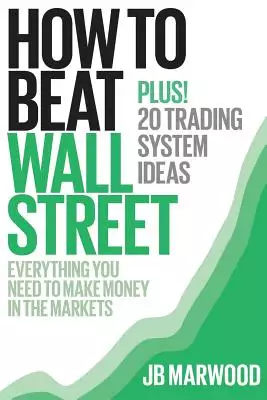amazon mechanical pe的問題,透過圖書和論文來找解法和答案更準確安心。 我們找到下列必買單品、推薦清單和精選懶人包
amazon mechanical pe的問題,我們搜遍了碩博士論文和台灣出版的書籍,推薦Marwood, J. B.寫的 How to Beat Wall Street: Everything You Need to Make Money in the Markets Plus! 20 Trading System Ideas 可以從中找到所需的評價。
國立臺灣大學 生物環境系統工程學研究所 廖中明所指導 陳季芸的 聚苯乙烯塑膠微粒對水域生物及小鼠之毒理動力/毒理動態模擬及暴露風險評估 (2018),提出amazon mechanical pe關鍵因素是什麼,來自於塑膠微粒、聚苯乙烯、貽貝、斑馬魚、紅尼羅吳郭魚、小鼠、毒理動力/毒理動態模式、風險評估。
而第二篇論文國立嘉義大學 園藝學系研究所 李堂察、盧柏松所指導 謝謹鴻的 鳳梨釋迦果實處理技術之改進 (2012),提出因為有 鳳梨釋迦、溫度、後熟、品質的重點而找出了 amazon mechanical pe的解答。
How to Beat Wall Street: Everything You Need to Make Money in the Markets Plus! 20 Trading System Ideas

為了解決amazon mechanical pe 的問題,作者Marwood, J. B. 這樣論述:
*Now includes Amibroker code for 20 trading system ideas* How to Beat Wall Street covers everything you need to get started trading in stocks, forex and commodities. This is the perfect book for someone looking for a solid overview of how to trade, from a seasoned professional trader. Plus... 20 pow
erful trading system ideas are introduced that anyone can use to trade in stocks on a variety of timeframes.What you will learn: - Trading fundamentals: central banks, macro-economics, Keynes and interest rates - Trading philosophies: trend following strategies, mean reversion techniques - Famous t
raders: Warren Buffett, Jim Rogers & George Soros - Timing: financial ratios, volatility analysis, Dow Theory, stock market cycles - Risk: money management techniques, trading psychology, Kelly criterion - Secrets & tips: news trading, volume analysis, seasonal patterns - Technical analysis: MACD, m
oving averages, Bollinger Bands, pivot points and naked price action - Trading systems: design & optimisation, 20 stock trading strategies, trend following strategies and mean reversion trading systems - Resources & bonus material: comprehensive resource material, tips for online trading, best tradi
ng books bibliography and bonus section.20 trading systems are back-tested on 10 years of historical data. Including: Trading System 1: Moving average crossover: A simple trend following trading system that uses moving averages to find trends in stocks. Trading System 2: 4 weeks up in a row: A sys
tem based on a profitable pattern of four consecutive higher opens. Trading System 3: Trading the noise: A system that finds stocks in smooth trends using a custom formula to calculate market noise. Trading System 4: Trading gradients: A mean reversion reversal system that finds extremely oversold
companies based on a custom formula. Plus many more trading strategies, ideas, and of course access to the full How to Beat Wall Street course.You will also learn: - How to trade non-farm payrolls and other news releases. - Volatility and sentiment analysis, bottom-up valuation techniques and PE
ratios. - Risk management and optimisation. Finally, you will also receive the tools you need to build your own winning trading system including Amibroker AFL code for every trading system in the book, free Excel stock value calculator and over 60 spreadsheets of historical economic data. "I would
put this on a top ten list of books for new traders and I have read hundreds and even written a few of those books myself." - Steve Burns, founder of newtraderu.com and Amazon Vine Voice. "The reason I am giving 5 stars is the generosity of the author in sharing trading system scripts and historica
l data. For the price paid its an absolute steal and a no-brainer." Please Note: If you have any problems accessing the extra material please contact the author directly. Joe Marwood is a seasoned trader and investor specialising in stock trading, stock investing, forex trading and trading systems
. He worked as a professional futures trader in London, England, before starting up his own private investment fund in 2012. He now trades a global portfolio of equities using a range of systematic and discretionary methods. Marwood began his career day trading the FTSE 100 future and German Bund an
d he worked right through the financial crisis of 2008/2009. He has a passion for building mechanical trading strategies and uses a blend of fundamental and technical analysis to find low-risk investment opportunities and short-term trades. He was taught by the former head of trading at a leading Ge
rman investment bank and is also an established financial writer, Udemy course instructor, author of a book on stock trading, and a regular Seeking Alpha contributor.
聚苯乙烯塑膠微粒對水域生物及小鼠之毒理動力/毒理動態模擬及暴露風險評估
為了解決amazon mechanical pe 的問題,作者陳季芸 這樣論述:
塑膠微粒可定義為粒徑小於5毫米之微小塑膠。近十年,塑膠微粒污染所衍生之生態隱憂與健康風險已引起全世界的關注。已有大量文獻指出塑膠微粒極可能累積於水域與陸域生物群中,然而以機制性觀點究其與生物體交互作用引發毒性之資訊則更為有限。本論文以毒理動力/動態模式擬合已發表之數據評估斑馬魚、紅尼羅吳郭魚及小鼠系統中,聚苯乙烯塑膠微粒於器官內累積與生物標誌反應。此外,本研究利用已發表之海洋與淡水生態系統中聚苯乙烯塑膠微粒之環境相關濃度數據,以推估包含貽貝之水域模式生物之暴露風險。本研究指出於特定粒徑之聚苯乙烯塑膠微粒暴露下,可得其於斑馬魚、紅尼羅吳郭魚及小鼠特定器官之毒理動力參數與體內平均停留時間。本研究
發現吸收速率常數最高分別於斑馬魚肝臟、紅尼羅吳郭魚與小鼠腸道中。結果顯示所有器官對聚苯乙烯塑膠微粒之生物濃縮因子皆遠大於1,顯示聚苯乙烯塑膠微粒於動物體內具潛在之累積能力。此外,與小鼠相比,斑馬魚器官對聚苯乙烯塑膠微粒普遍具較高之生物濃縮因子。聚苯乙烯塑膠微粒於生物體肝臟內誘發之免疫反應、氧化壓力、解毒能力、能量與脂肪代謝,可藉由毒理動態評估以決定生物標誌之敏感性。基於劑量反應分析之擬合結果,這些濃度與效應間之關係隨各系統使用物種、暴露時間及聚苯乙烯塑膠微粒粒徑不同而變化,導致聚苯乙烯塑膠微粒之毒性閾值具有很大之變異。由嚴謹的閾值濃度結果顯示,各系統受聚苯乙烯塑膠微粒暴露下,反應最敏感之生物標
誌分別為貽貝:巨噬細胞;斑馬魚:超氧化物歧化酶;紅尼羅吳郭魚:7-乙氧基異酚惡唑正脫乙基酶;及小鼠:超氧化物歧化酶。本研究進一步使用以風險為基礎之機率模式,整合聚苯乙烯塑膠微粒之預測環境濃度值,以超越風險與危害商數量化海洋貽貝與淡水魚所受之潛在危害。全球五大塑料環流中,北太平洋對貽貝造成之風險為最高,而南太平洋海域則最低。而就淡水魚而言,美國之溫約灣於所有選定的淡水域中具最高風險。針對全球塑膠微粒污染造成水域生物之危害,本研究結果值得予以關注,特別是敏感性物種如斑馬魚將首當其衝受到長期毒性之風險。此外,以小鼠為模式生物所得之毒理動力參數與閾值標準有助於研究之健全規劃,以評估塑膠微粒於人體攝食之
危害。本研究提出一濃度外推架構,以健康風險評估觀點,機制性地從小鼠推估至人類體內塑膠微粒毒性閾值。總體而言,由毒理動力/動態評估、韋伯閾值模式及生態風險評估所得之結果,可應用於快速檢測及評估各種塑膠微粒濃度暴露下所誘發之毒性影響。嚴謹之塑膠微粒閾值可作為環境管理之建議值,且可提供人體攝食風險評估計畫建立之工具。
鳳梨釋迦果實處理技術之改進
為了解決amazon mechanical pe 的問題,作者謝謹鴻 這樣論述:
本試驗研究之目的為探討鳳梨釋迦果實採收後品質的變化,藉由採前和採後處理方法來延長果實貯藏壽命和增進食用品質。鳳梨釋迦果實最合適的後熟溫度為15℃至25℃間;貯藏溫度低於10℃,果實則無法正常軟熟。開花前噴施Apogee和水楊酸處理之果實採收後於25℃下,果實後熟天數較未處理之果實延後1天,對品質則無差異。採收前噴水楊酸和AVG處理之果實,於25℃下對果實之後熟及品質沒有影響。採收前噴AVG、採收後AVG及1-MCP處理,果實採後於25℃下不影響其呼吸率;若採收前噴AVG+1-MCP處理則可以減緩呼吸速率;採前噴AVG+1-MCP、1-MCP和採收後AVG處理之果實於25℃下,乙烯釋放量較其他
處理低,可延緩果實後熟1天,且不影響果實品質。於25℃下後熟3和5天再分別於5℃、7.5℃和10℃低溫下貯藏之果實,在貯藏的期間,果實仍然可以軟熟;後熟程度較高之果實經低溫貯藏後可以減少寒害之發生,且軟熟後之食用品質較佳。果實採收後於25℃下不同後熟天數,並經溫湯處理後貯藏於1℃和5℃下,可以減緩寒害症狀的發生,且不影響果實品質;果實後熟3和5天後貯藏於1℃和5℃下,有較高的食用品質。果實採收後於25℃下3天,將果實以PE袋和保鮮膜包裝,於5℃下貯藏11天後,將果實移置25℃下後,PE袋包裝之果實後熟速率較對照組及保鮮膜包裝之果實較慢1天,但食用品質較差。田間軟熟之鳳梨釋迦果實以PE袋和保鮮膜
包裝,於5℃下貯藏7和14天,結果顯示不同包裝對果實品質無顯著之影響;但果實食用品質隨貯藏天數的增加而降低。